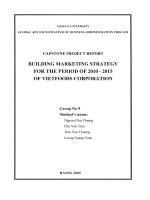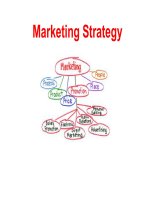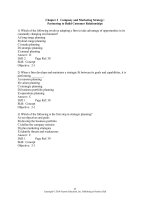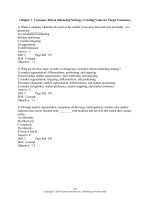Marketing Strategy
Bạn đang xem bản rút gọn của tài liệu. Xem và tải ngay bản đầy đủ của tài liệu tại đây (334.27 KB, 62 trang )
Marketing Strategy
COURSE OUTLINE
Part 1 : What is Marketing ?
Part 2 : Importance of Marketing.
Part 3 : Marketing Plan.
Part 4 : Marketing Strategy.
Part 5 : Positioning.
PART 1
WHAT IS MARKETING ?
What is Marketing?
• It is the most interesting, dynamic, versatile of all
academic disciplines
• It is both theoretical and practical in nature
• It yields real results in the form of profits and/or
satisfaction of business aims/objectives
• Overall, it enhances human and national
economic development/progress
What is Marketing?
1. Marketing is an organizational function and a set
of processes for creating, communicating and
delivering value to customers and for managing
customer relationships in ways that benefit the
organization and its stakeholders
2. Marketing is a societal process by which
individuals and groups obtain what they need
and want through creating, offering, and freely
exchanging products and services of value with
others
Recent formal Definition of
Marketing
• Marketing is an organizational function and a set
of processes for creating, communicating, and
delivering value to customers and for managing
customer relationships in ways that benefit the
organization and its stakeholders.
Source: American Marketing Association, 2004
The Marketing Concept (key issues)
• Organizations must concentrate on the customer
and not the product or the company.
• Organizations should revolve round the customer
and not the other way around.
• The purpose of a business is to create and keep a
customer (Theodore Levitt).
Some Criticisms of Marketing
• Too many advertisements are annoying,
misleading, or both.
• There are too many unnecessary products.
• Middlemen raise prices but don’t add value.
• Marketing makes people materialistic.
• Most of the criticisms result from
misunderstandings about marketing (Perreault &
McCarthy, 1999).
Do you know your market?
• What is the product or service being offered?
• What are the market trends in the industry?
• What is the market?
• Who are your customers? And what are they
looking for?
• Who are your competitors? And how do they
operate/react/behave?
• Why do (should) your customers buy your
product/service rather than that of your
competitors?
What is Marketed?
• Goods
• Places
• Services
• Properties
• Events
• Organizations
• Experiences
• Information
• Persons
• Ideas
Marketing vs Sales
Peter Drucker
“The aim of marketing is to make sales
superfluous”.
Marketing vs Sales
• Marketing is a more comprehensive process.
• Sales – focus on needs of Seller.
• Marketing – focus on needs of buyer.
• Selling has a short term outlook.
• Marketing has a long term vision.
Group Activity
• ‘There are too many unnecessary products.’ in
the market
• What is your opinion?
• Why?
PART 2
IMPORTANCE OF
MARKETING ?
Importance of Marketing
• According to the Customer Service Institute, it
costs as much as five times as much to acquire a
new customer than it does to service an existing
one.
• Customers tell twice as many people about a bad
experience over a good one.
• For an average company, 65% of its business
comes from its presently satisfied customers.
What is a Market ?
• According to Kotler (2004), “a market consist of
all the potential customers sharing a particular
need or want who might be willing and able (i.e.,
propensity to) to engage in exchange to satisfy
that need or want”.
Source: Kotler, P. (2004), Marketing Management, Prentice-Hall,
Englewood Cliff, NJ.
Market Types
• Consumer Markets
• Industrial/Business to Business Markets
• Reseller (Retailers, Distributors) Markets
• Publics (Government
agencies/departments/institutions)
• International/global Markets
Market Orientation
• Production Orientation
- 1850s -> 1930s
• Sales Orientation
- 1930s -> 1950s
Time
• Marketing Orientation
- 1960s -> ??
• Consumer Relationship Marketing (CRM)
- 1990s -> ??
Product Orientation
• Focus on the technical perfection of the
product/service seen through the producer’s
(firm) eyes.
• Assumes customers will perceive
product/service in the same way and thus buy.
Selling Orientation
• Focus on persuading (usually aggressive)
customers to buy products which do not usually
match their requirements.
• This is unlikely to lead to repeat buy/business.
Customer Orientation
• Focus on discovering customer needs (basic
survey/question & answer type) and satisfying them.
• This is unlikely to make best uses of production
and other organizational resources.
Marketing Orientation
• Focus on the identification of customers needs,
organizational resources and objectives.
• Achieve effective match through market
segmentation, targeting, positioning and
resource development.
Social Responsibility and
Marketing Ethics
• Social responsibility concerns a firm’s
obligation to improve its positive effects on
society and reduce its negative effects.
• Marketing ethics are the moral standards that
guide marketing decisions and actions.
Needs, Wants, Demand
• Needs are basic human requirements
• Wants are needs directed to specific
objects/services that might satisfy the need
• Demand - this is the wants for specific
products backed by an ability to pay
Segmentation, Targeting,
Positioning
• Segmentation: grouping consumers by some
criteria
• Targeting: choosing which group(s) to sell to
• Positioning: select the marketing mix most
appropriate for the target segment(s)









